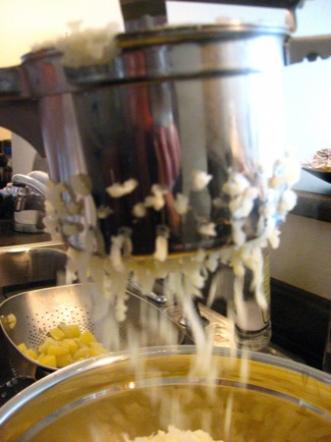I, like the other 10,000 Korean adoptees in Minnesota, have suffered from mild identity confusion. As Kim Jackson, author of HERE: A Visual History of Adopted Koreans in Minnesota states, there is at least one of us for every lake.
 My family recently gave me this self-portrait on a plate that I designed in 1st grade. I giggled as I noticed my blond hair. Life as a Korean, adopted by a family of suburban Scandinavians in Apple Valley, was certainly enough to induce some moments of identity confusion. When I was young, I wished I were Scandinavian. Now that I’m older, I want to embrace both Korean and Scandinavian traditions. Some may find it strange that I make both world-class Swedish meatballs and Korean galbi short ribs.
My family recently gave me this self-portrait on a plate that I designed in 1st grade. I giggled as I noticed my blond hair. Life as a Korean, adopted by a family of suburban Scandinavians in Apple Valley, was certainly enough to induce some moments of identity confusion. When I was young, I wished I were Scandinavian. Now that I’m older, I want to embrace both Korean and Scandinavian traditions. Some may find it strange that I make both world-class Swedish meatballs and Korean galbi short ribs.
Each Christmas, my mom’s family contributed a tray of lefse. I always looked forward to munching on these cigar-sized delicacies rolled up with butter and brown sugar. If we were lucky, our family gave us leftovers to savor. Post college, I finally joined the Dahlen clan’s annual lefse-making party and left with the lingering desire to make my own. Homemade lefse is delicate and silky, a contrast to the dry, flat-flavored versions available at the store.
 A ricer is quite handyYou do not need to purchase all of the special lefse-making tools, as my family makes their version with what they have, including rolling pins, cloth, pots, and pans. However, I consider a potato ricer or food mill essential, and felt inspired to purchase a pastry cloth, rolling pin cover, and decorated lefse stick. If you don’t have pastry cloth, use a clean towel and if you don’t have a rolling pin cover, don’t worry about it. The lefse stick helped transfer the paper-thin dough to the skillet, but if you aren’t hell-bent on paper thin perfection, don’t purchase the stick. My family certainly never did.
A ricer is quite handyYou do not need to purchase all of the special lefse-making tools, as my family makes their version with what they have, including rolling pins, cloth, pots, and pans. However, I consider a potato ricer or food mill essential, and felt inspired to purchase a pastry cloth, rolling pin cover, and decorated lefse stick. If you don’t have pastry cloth, use a clean towel and if you don’t have a rolling pin cover, don’t worry about it. The lefse stick helped transfer the paper-thin dough to the skillet, but if you aren’t hell-bent on paper thin perfection, don’t purchase the stick. My family certainly never did.
A few cook’s notes before diving in:
Although I mainly followed the “from scratch” recipe in “Lefse from Scratch: Worth the effort?” by Heavy Table writer Lori Writer, this recipe is also essentially identical to my family's recipe as well as those in my vintage Lutheran church cookbooks. These wonderful Norwegian grandmothers must operate on the same wavelength.
Since potatoes rank in the “dirty dozen” list of produce items containing high levels of pesticide, I found a bag of locally grown organic russets at my grocery store for $5. Before beginning, keep in mind that once you add the flour to the chilled potato mixture, you should make your lefse relatively quickly. Otherwise, the dough will release moisture (and the addition of even more flour will make your dough less delicate and tender).
This makes a double recipe and you will be happy you have extra since it’s not the kind of recipe you will have time to make each week. Leftovers can be refrigerated or frozen.
Ingredients
13 small-medium russet potatoes
7 Tablespoons of unsalted butter
1 Tablespoon of organic cane sugar
1 1/2 teaspoons salt
1 cup of heavy cream, plus a few dribbles
About 3 ½ cups of unbleached, all purpose flour
Day One: Preparing the potatoes.
The day before you cook your lefse, prepare the potatoes so they can chill overnight.
Peel your potatoes and cut into small chunks. Place them in a pot and cover with enough cold water to cover. Bring to a boil and add a dash of salt. Cover and simmer until tender (about 15 minutes).
Drain your potatoes. While the potatoes are still hot, process them in a ricer or food mill, twice.
Mix the warm, fluffy potatoes with the butter, salt, and sugar. Then, incorporate the heavy cream. Place in your fridge or on your front step, overnight, or until completely cooled.
Day Two: Making Lefse
Making dough: Slowly add flour to the cold potato mixture.
The dough will begin to thicken. When it holds together, turn it onto a flat surface and knead in just enough flour for the dough to develop some elasticity (I used about 3 ½ cups). Less flour will produce tender and delicate lefse.
Roll the dough into balls, cover, and refrigerate for about an hour or until they are cold.
Preheat a pan or electric griddle to about 400 degrees F.
Rolling out and cooking the dough: Wrap a cutting board with a clean towel or pastry cloth. Generously spread with flour. If you are using a rolling pin sleeve, coat your pin in flour. The dough is moist and sticky and may stick to your board or covered pin. I had to flour my pin and board before rolling out each dough ball. When the dough stuck, I scraped as much of the stuck dough as possible and then smushed with flour until the spot was not sticky anymore. 
Only remove a few dough balls from the refrigerator at a time so they remain cold.
Roll each ball as thinly as possible and carefully transfer to a hot pan or griddle.
Cook until bubbles start to form and then flip. If cooked too long or until the bubbles are dark brown, the lefse may be crispy around the edges.
Spread with butter, brown sugar, and a tiny pinch of sea salt. Roll-up and enjoy.
Stack the lefse on a pan or plate and cover with a clean towel. Cool completely before storing in plastic bags or cling wrap. May be frozen and then defrosted or warmed in the microwave.
Don't forget to enjoy feeling a little bit more Norwegian and remember that even imperfect lefse are still delicious.

Jeni Hill grew up in the Twin Cities and recently moved to Fargo. Her two sustaining passions are food and writing and she combines the two whenever she gets the chance. Jeni believes food is never just about the food and considers it the finest medium to connect with others. When she is not crafting contributions to Simple Good & Tasty, she may be posting to her blog An Herbalist Eats, 20food, or Fargo's High Plains Reader. Her last article for us was: A food lover in Fargo.




